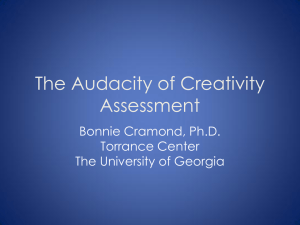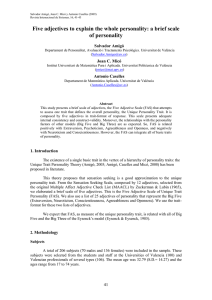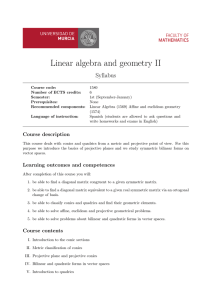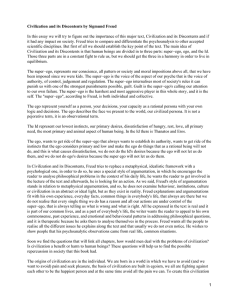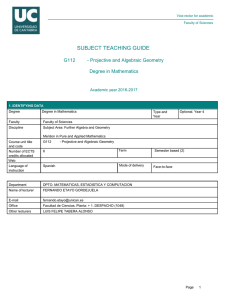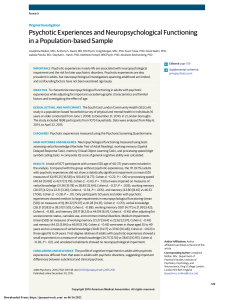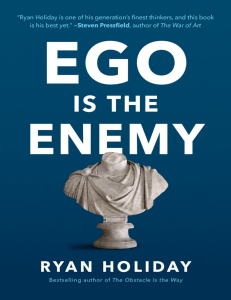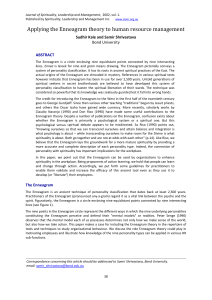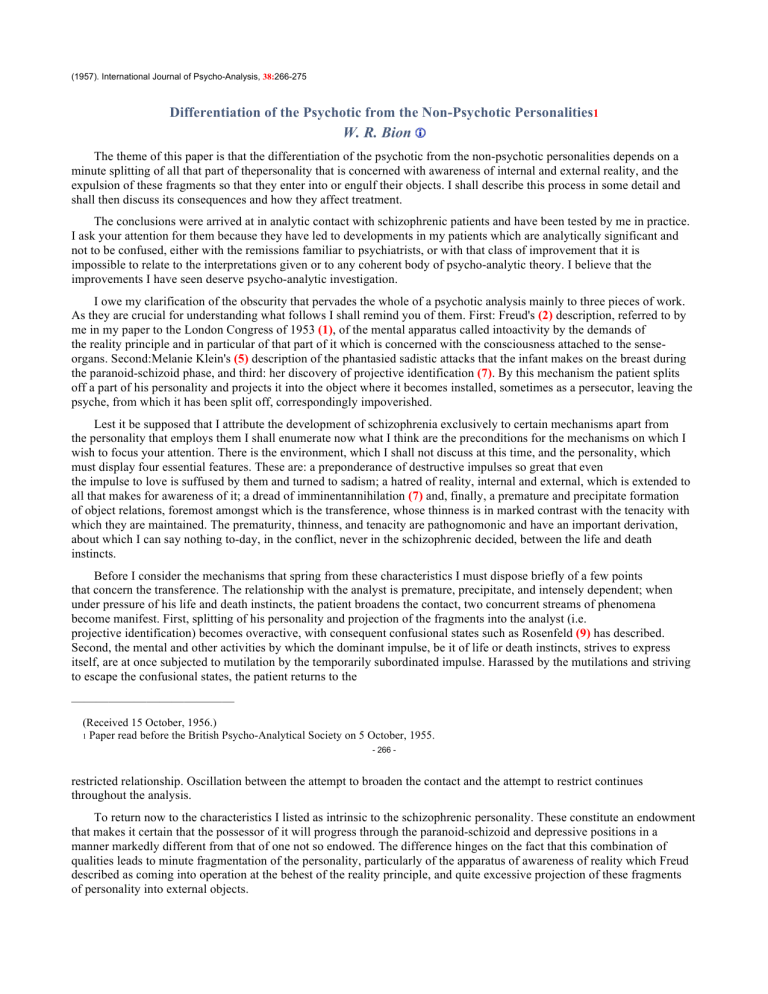
(1957). International Journal of Psycho-Analysis, 38:266-275 Differentiation of the Psychotic from the Non-Psychotic Personalities1 W. R. Bion The theme of this paper is that the differentiation of the psychotic from the non-psychotic personalities depends on a minute splitting of all that part of thepersonality that is concerned with awareness of internal and external reality, and the expulsion of these fragments so that they enter into or engulf their objects. I shall describe this process in some detail and shall then discuss its consequences and how they affect treatment. The conclusions were arrived at in analytic contact with schizophrenic patients and have been tested by me in practice. I ask your attention for them because they have led to developments in my patients which are analytically significant and not to be confused, either with the remissions familiar to psychiatrists, or with that class of improvement that it is impossible to relate to the interpretations given or to any coherent body of psycho-analytic theory. I believe that the improvements I have seen deserve psycho-analytic investigation. I owe my clarification of the obscurity that pervades the whole of a psychotic analysis mainly to three pieces of work. As they are crucial for understanding what follows I shall remind you of them. First: Freud's (2) description, referred to by me in my paper to the London Congress of 1953 (1), of the mental apparatus called intoactivity by the demands of the reality principle and in particular of that part of it which is concerned with the consciousness attached to the senseorgans. Second:Melanie Klein's (5) description of the phantasied sadistic attacks that the infant makes on the breast during the paranoid-schizoid phase, and third: her discovery of projective identification (7). By this mechanism the patient splits off a part of his personality and projects it into the object where it becomes installed, sometimes as a persecutor, leaving the psyche, from which it has been split off, correspondingly impoverished. Lest it be supposed that I attribute the development of schizophrenia exclusively to certain mechanisms apart from the personality that employs them I shall enumerate now what I think are the preconditions for the mechanisms on which I wish to focus your attention. There is the environment, which I shall not discuss at this time, and the personality, which must display four essential features. These are: a preponderance of destructive impulses so great that even the impulse to love is suffused by them and turned to sadism; a hatred of reality, internal and external, which is extended to all that makes for awareness of it; a dread of imminentannihilation (7) and, finally, a premature and precipitate formation of object relations, foremost amongst which is the transference, whose thinness is in marked contrast with the tenacity with which they are maintained. The prematurity, thinness, and tenacity are pathognomonic and have an important derivation, about which I can say nothing to-day, in the conflict, never in the schizophrenic decided, between the life and death instincts. Before I consider the mechanisms that spring from these characteristics I must dispose briefly of a few points that concern the transference. The relationship with the analyst is premature, precipitate, and intensely dependent; when under pressure of his life and death instincts, the patient broadens the contact, two concurrent streams of phenomena become manifest. First, splitting of his personality and projection of the fragments into the analyst (i.e. projective identification) becomes overactive, with consequent confusional states such as Rosenfeld (9) has described. Second, the mental and other activities by which the dominant impulse, be it of life or death instincts, strives to express itself, are at once subjected to mutilation by the temporarily subordinated impulse. Harassed by the mutilations and striving to escape the confusional states, the patient returns to the ————————————— (Received 15 October, 1956.) 1 Paper read before the British Psycho-Analytical Society on 5 October, 1955. - 266 - restricted relationship. Oscillation between the attempt to broaden the contact and the attempt to restrict continues throughout the analysis. To return now to the characteristics I listed as intrinsic to the schizophrenic personality. These constitute an endowment that makes it certain that the possessor of it will progress through the paranoid-schizoid and depressive positions in a manner markedly different from that of one not so endowed. The difference hinges on the fact that this combination of qualities leads to minute fragmentation of the personality, particularly of the apparatus of awareness of reality which Freud described as coming into operation at the behest of the reality principle, and quite excessive projection of these fragments of personality into external objects. I described some aspects of these theories in my paper to the International Congress of 1953 (1) when I was speaking of the association of the depressive positionwith the development of verbal thought and the significance of this association for awareness of internal and external reality. In this paper I am taking up the same story only at a much earlier stage, namely at the outset of the patient's life. I am dealing with phenomena in the paranoid-schizoid position which are associated ultimately with the inchoation of verbal thought. How this should be so will, I hope, presently emerge. The theories of Freud and Melanie Klein to which I referred earlier must now be considered in more detail. Quoting his formulation in his paper on 'Neurosis and Psychosis' in 1924, Freud defined one of the features distinguishing the neuroses from the psychoses as: 'in the former the ego, in virtue of its allegiance to reality, suppresses a part of the id (the life of instinct), whereas in the psychoses the same ego in the service of the id, withdraws itself from a part of reality' (4). I assume that when Freud speaks of the allegiance of the ego to reality he is speaking of the developments he described as taking place with the institution of the reality principle. He said, 'the new demands made a succession of adaptations necessary in the mental apparatus, which, on account of insufficient or uncertain knowledge, we can only detail very cursorily'. He then lists: the heightened significance of the sense organs directed towards the outer world and of the consciousness attached to them; attention, which he calls a special function which had to search the outer world in order that its data might be already familiar if an urgent inner need should arise; a system of notation whose task was to deposit the results of this periodical activity of consciousness which he describes as a part of that which we call memory;judgement which had to decide whether a particular idea was true or false; the employment of motor discharge in appropriate alteration of reality and not simply in unburdening the mental apparatus of accretions of stimuli; and, finally, thought which he says made it possible to tolerate the frustration which is an inevitable accompaniment of action by virtue of its quality as an experimental way of acting. As will be seen I very much extend the function and importance of thought, but otherwise accept this classification of ego function, which Freud put forward as putative, as giving concreteness to a part of the personality with which this paper is concerned. It accords well with clinical experience and illuminates events which I should have found infinitely more obscure without it. I would make two modifications in Freud's description to bring it into closer relation with the facts. I do not think, at least as touches those patients likely to be met with in analytic practice, that the ego is ever wholly withdrawn from reality. I would say that its contact with reality is masked by the dominance, in the patient's mind and behaviour, of an omnipotent phantasy that is intended to destroy either reality or the awareness of it, and thus to achieve a state that is neither life nor death. Since contact with reality is never entirely lost, the phenomena which we are accustomed to associate with the neuroses are never absent and serve to complicate the analysis, when sufficient progress has been made, by their presence amidst psychotic material. On this fact, that the ego retains contact with reality, depends the existence of a non-psychotic personality parallel with, but obscured by, the psychotic personality. My second modification is that the withdrawal from reality is an illusion, not a fact, and arises from the deployment of projective identification against the mental apparatus listed by Freud. Such is the dominance of this phantasy that it is evident that it is no phantasy, but a fact, to the patient, who acts as if his perceptual apparatus could be split into minute fragments and projected into his objects. As a result of these modifications we reach the conclusion that patients ill enough, say, to be certified as psychotic, contain in their psyche a non-psychotic part of the personality, a prey - 267 - to the various neurotic mechanisms with which psycho-analysis has made us familiar, and a psychotic part of the personality which is so far dominant that the non-psychotic part of the personality, with which it exists in negative juxtaposition, is obscured. One concomitant of the hatred of reality that Freud remarked is the psychotic infant's phantasies of sadistic attacks on the breast which Melanie Klein described as a part of the paranoid-schizoid phase (7). I wish to emphasize that in this phase the psychotic splits his objects, and contemporaneously all that part of his personality, which would make him aware of the reality he hates, into exceedingly minute fragments, for it is this that contributes materially to the psychotic's feeling that he cannot restore his objects or his ego. As a result of these splitting attacks, all those features of the personality which should one day provide the foundation for intuitive understanding of himself and others are jeopardized at the outset. All the functions which Freud described as being, at a later stage, a developmental response to thereality principle, that is to say, consciousness of sense impressions, attention, memory, judgement, thought, have brought against them, in such inchoate forms as they may possess at the outset of life, the sadistic splitting eviscerating attacks that lead to their being minutely fragmented and then expelled from the personality to penetrate, or encyst, the objects. In the patient's phantasy the expelled particles of ego lead an independent and uncontrolled existence, either contained by or containingthe external objects; they continue to exercise their functions as if the ordeal to which they have been subjected had served only to increase their number and provoke their hostility to the psyche that ejected them. In consequence the patient feels himself to be surrounded by bizarre objects whose nature I shall now describe. Each particle is felt to consist of a real object which is encapsulated in a piece of personality that has engulfed it. The nature of this complete particle will depend partly on the character of the real object, say a gramophone, and partly on the character of the particle of personality that engulfs it. If the piece of personality is concerned with sight, the gramophone when played is felt to be watching the patient; if with hearing, then the gramophone when played is felt to be listening to the patient. The object, angered at being engulfed, swells up, so to speak, and suffuses and controls the piece of personality that engulfs it: to that extent the particle ofpersonality has become a thing. Since these particles are what the patient depends on for use as the prototypes of ideas—later to form the matrix from which words should spring—this suffusion of the piece of personality by the contained but controlling object leads the patient to feel that words are the actual things they name and so adds to the confusions, described by Segal, that arise because the patient equates, but does not symbolize. The fact that the patient uses these bizarre objects for achieving thought leads now to a fresh problem. If we consider that one of the patient's objects in using splitting and projective identification is to rid himself of awareness of reality it is clear that he could achieve the maximum of severance from reality with the greatest economy of effort if he could launch these destructive attacks on the link, whatever it is, that connects sense impressions with consciousness. In my paper to the 1953 International Congress (1) I showed that awareness ofpsychic reality depended on the development of a capacity for verbal thought the foundation of which was linked with the depressive position. It is impossible to go into this now. I refer you to Melanie Klein's 1930 paper on 'The Importance of Symbol-formation in the Development of the Ego' (6) and to the paper given to the British Psychological Society (1955) by H. Segal (10). In this, Segal demonstrates the importance of symbol formation and explores its relationship to verbal thought and the reparative drives normally associated with the depressive position. I am concerned with an earlier stage in the same story. It is my belief that the mischief that becomes much more apparent in the depressive position has in fact been initiated in the paranoid-schizoid phase when the foundations for primitive thought should be laid, but are not, because of the overaction of splitting and projective identification. Freud attributes to thought the function of providing a means of restraint of action. But he goes on to say, 'It is probable that thinking was originally unconscious, in so far as it rose above mere ideation and turned to the relations between the object-impressions, and that it became endowed with further qualities which were perceptible to consciousness only through its connection with the memory traces of words' (2). My experiences have led me to suppose that some kind of thought, related to what we should call ideographs and sight rather than to words and hearing, exists at the outset. This - 268 - thought depends on a capacity for balanced introjection and projection of objects and, a fortiori, on awareness of them. This is within the capacity of the non-psychotic part of the personality, partly because of the splitting and ejection of the apparatus of awareness I have already described and partly for reasons I am coming to now. Thanks to the operations of the non-psychotic part of the personality the patient is aware that introjection is leading to the formation of the unconscious thought of which Freud speaks as 'turned to the relations between object-impressions'. Now I believe that it is this unconscious thought which Freud describes as turned to the relations between the objectimpressions which is responsible for the 'consciousness attached to' the sense impressions. I am fortified in this belief by his statement twelve years later in the paper on 'The Ego and the Id'. In this he says 'that the question "How does a thing become conscious?" could be put more advantageously thus: "How does a thing become pre-conscious?" And the answer would be: "By coming into connection with the verbal images that correspond to it"' (3). In my 1953 paper I said that verbal thought is bound up with awareness of psychic reality (1); this I also believe to be true of the early pre-verbal thought of which I am now speaking. In view of what I have already said of the psychotic's attacks on all that mental apparatus that leads to consciousness of external and internal reality, it is to be expected that the deployment of projective identification would be particularly severe against the thought, of whatsoever kind, that turned to the relations between object-impressions, for if this link could be severed, or better still never forged, then at least consciousness of reality would be destroyed even though reality itself could not be. But in fact the work of destruction is already half done as the material from which thought is forged, in the non-psychotic by balanced introjection and projection, is not available to the psychotic part of the personality, because the displacement of projection and introjection by projective identification has left him only with thebizarre objects I have described. In fact, not only is primitive thought attacked because it links sense-impressions of reality with consciousness but, thanks to the psychotic's over-endowment with destructiveness, the splitting processes are extended to the links within the thought processes themselves. As Freud's phrase regarding thought being turned to the relations between object-impressions implies, this primitive matrix of ideographs from which thought springs contains within itself links between one ideograph and another. All these are now attacked till finally two objects cannot be brought together in a way which leaves each object with its intrinsic qualities intact and yet able, by their conjunction, to produce a new mental object. Consequently the formation of symbols, which depends for its therapeutic effect on the ability to bring together two objects so that their resemblance is made manifest, yet their difference left unimpaired, now becomes difficult. At a still later stage the result of these splittingattacks is seen in the denial of articulation as a principle for the combining of words. This last does not mean that objects cannot be brought together; as I shall show later when speaking of agglomeration, that is by no means true. Further, since that-which-links has been not only minutely fragmented but also projected out into objects to join the other bizarre objects, the patient feels surrounded by minute links which, being impregnated now with cruelty, link objects together cruelly. To conclude my description of the fragmentation of the ego and its expulsion into and about its objects, I shall say that I believe the processes I have described to be the central factor, in so far as such a factor can be isolated without distortion, in the differentiation of the psychotic from the non-psychotic part of the personality. It takes place at the outset of the patient's life. The sadistic attacks on the ego and on the matrix of thought, together with projective identification of the fragments, make it certain that from this point on there is an ever-widening divergence between the psychotic and non-psychotic parts of the personality until at last the gulf between them is felt to be unbridgeable. The consequences for the patient are that he now moves, not in a world of dreams, but in a world of objects which are ordinarily the furniture of dreams. His sense impressions appear to have suffered mutilation of a kind which would be appropriate had they been attacked as the breast is felt to be attacked in the sadistic phantasies of the infant (5). The patient feels imprisoned in the state of mind he has achieved, and unable to escape from it because he feels he lacks the apparatus of awareness ofreality which is both the key to escape and the freedom to which he would escape. The sense of imprisonment - 269 - is intensified by the menacing presence of the expelled fragments within whose planetary movements he is contained. These objects, primitive yet complex, partake of qualities which in the non-psychotic personality are peculiar to matter, anal objects, senses, ideas and superego. The diversity of such objects, dependent as it is on the sense by which they are suffused, prevents more than the cursory indication of their mode of genesis than I have given. The relation of these objects to material for ideographic thought leads the patient to confound real objects with primitive ideas and therefore to confusion when they obey the laws of natural science and not those of mental functioning. If he wishes to bring back any of these objects in an attempt at restitution of the ego, and in analysis he feels impelled to make the attempt, he has to bring them back by projective identification in reverse and by the route by which they were expelled. Whether he feels he has had one of these objects put into him by the analyst, or whether he feels he has taken it in, he feels the ingress as an assault. The extreme degree to which he has carried the splitting of objects and ego alike makes any attempt at synthesis hazardous. Furthermore, as he has rid himself of thatwhich-joins, his capacity for articulation, the methods available for synthesis are felt to be macilent; he can compress but cannot join, he can fuse but cannot articulate. The capacity to join is felt, as a result of its ejection, to have become, like all other expelled particles, infinitely worse than they were when ejected. Any joining that takes place is done with a vengeance, that is to say in a manner expressly contrary to the wishes of the patient at the moment. In the course of the analysis this process of compression or agglomeration loses some of its malignancy and then fresh problems arise. I must now draw your attention to a matter that demands a paper to itself and therefore cannot be more than mentioned here. It is implicit in my description that the psychotic personality or part of the personality has used splitting and projective identification as a substitute for repression. Where the non-psychotic part of thepersonality resorts to repression as a means of cutting off certain trends in the mind both from consciousness and from other forms of manifestation and activity, the psychotic part of the personality has attempted to rid itself of the apparatus on which the psyche depends to carry out the repressions; the unconscious would seem to be replaced by the world of dream furniture. I shall now attempt a description of an actual session; it is a clinical experience based on these theories rather than the description of an experience on which the theories are based, but I hope I shall be able to indicate the material from previous sessions which led me to interpret as I did. The patient at the time of this session, of which I describe a small part, had been coming to me for six years. He had once been as late as forty-five minutes, but had never missed a session; the sessions were never continued over time. On this morning he arrived a quarter of an hour late and lay on the couch. He spent some time turning from one side to another, ostensibly making himself comfortable. At length he said: 'I don't suppose I shall do anything today. I ought to have rung up mymother.' He paused, and then said: 'No; I thought it would be like this.' A more prolonged pause followed; then, 'Nothing but filthy things and smells', he said. 'I think I've lost my sight.' Some twenty-five minutes of our time had now passed, and at this point I made an interpretation, but before I repeat it I must discuss some previousmaterial which will, I hope, make my intervention comprehensible. When the patient was manoeuvring on the couch I was watching something with which I was familiar. Five years earlier he had explained that his doctor advised an operation for hernia and it was to be assumed that the discomfort caused by the hernia compelled these adjustments. It was, however, evident that more was involved than the hernia and rational activity to increase his physical comfort. I had sometimes asked him what these movements were, and to these questions his reply had been, 'Nothing'. Once he had said, 'I don't know'. I had felt that 'Nothing' was a thinly veiled invitation to me to mind my own business as well as a denial of something very bad. I continued, over the weeks and years, to watch his movements. A handkerchief was disposed near his right pocket; he arched his back—surely a sexual gesture here? A lighter fell out of his pocket. Should he pick it up? Yes. No, perhaps not. Well, yes. It was retrieved from the floor and placed by the handkerchief. Immediately a shower of coins spilled over the couch on to the floor. The patient lay still and waited. Perhaps, his gestures seemed to suggest, he had been unwise to bring - 270 - back the lighter. It had seemed to lead to the shower of coins. He waited, cautiously, furtively. And finally he made the remark I have reported. It reminded me of his descriptions, not given in any one session but produced over many months, of the tortuous manoeuvres through which he had to go before he went to the lavatory, or went down to breakfast, or telephoned to his mother. I was quite used to recalling many of the free associations which might easily be appropriate to the behaviour he displayed on this as on many other mornings. But these were now my associations, and once when I had tried to make use of such material in an interpretation that is exactly the reply he had made. One interpretation I remembered which had met with some success. I had pointed out that he felt much the same about these movements as he had about a dream he had told me—he had no ideas about the dream and he had agreed, 'that's so'. 'And yet', I replied, 'you once had an idea about it; you thought it was the hernia.' 'That's nothing', he replied, and had then paused, almost slyly I thought, to see if I had grasped the point. So, 'Nothing is really a hernia', I said. 'Noidea', he replied, 'only a hernia.' I had been left feeling that his 'no idea' was very like the 'no ideas' about the dreams or the movements, but for that session at least I could get no further. In this respect the movements and the dreams were very fair instances of mutilated attempts at cooperation, and this too was something to which I had drawn his attention. It may have occurred to you, as it often had to me, that I was watching a series of miniature dramatic presentations, preparations for a baby's bath or feed, or a change of nappies, or a sexual seduction. More often it would be correct to say that the presentation was a conglomeration of bits out of a number of such scenes, and it was this impression that led me finally to suppose that I was watching an ideomotor activity, that is to say a means of expressing an idea without naming it. From this it was a short step to think of it as the kind of motor activity which Freud had described as characteristic of the supremacy of the pleasure principle (1). For, in so far as I was watching psychotic phenomena, the patient could not be acting in response to awareness of external reality; he was exhibiting the kind of motor discharge which Freud said under the supremacy of the pleasure principle 'had served to unburden the mental apparatus of accretions of stimuli, and in carrying out this task had sent innervations into the interior of the body (mien expressions of affect).' It was this impression which returned to me when the patient said, 'I don't expect I shall do anything today.' It was a remark that could refer to the likelihood of his producing any material for interpretation or, equally, to the likelihood that I would produce any interpretations. 'I ought to have rung up my mother' could mean that his failure to do so was being visited upon him by the punishment of not being able to do anyanalysis. It also meant that his mother would have known what to do about it— she could get associations out of him or interpretations out of me; something depended on what his mother meant to him, but on this point I was really in the dark. She had come in to the analysis as a simple working-class woman who had to go to work for the family; this view was entertained with the same degree of conviction that stamped his statements that the family were extremely wealthy. I was vouchsafed glimpses of her as a woman with such multitudinous social engagements that scant time was left her to satisfy the needs either of the patient, who was her eldest son, her eldest daughter, two years older than the patient, or the remainder of the family. She had been spoken of, if anything so inarticulate could be described as speech, as devoid of common sense or culture, though in the habit of visiting art galleries of international fame. I was left to infer that the bringing up of her children was ignorant and painstaking in the extreme. I may say that at the time of which I write I knew little more of his real mother than would be known by a person who had rid himself of his ego in the way I have described as typical of the psychotic personality. Nevertheless I had these impressions, and others which I omit, and on them I based my interpretations. The patient's responses to these interpretations were outright rejection as either quite inadmissible because wrong, or accurate but improperly arrived at in that I must have been using his mind (really his capacity for contact with reality) without his permission. It will be observed that he thereby expresses a jealousdenial of my insight. When the patient said, after a pause, that he knew it would be like this, I felt on fairly sure ground in assuming that it was I who was unlikely to do anything in that session and that his mother was some person or thing who could have enabled him to deal with me more satisfactorily. This - 271 - impression was strengthened by the next association. If the theories I have described are correct, then, in any given situation, the patient who is ill enough, as this one was, to have achieved certification, has two main problems to solve, one appertaining to the non-psychotic part of the personality and one to the psychotic part. With this particular patient, at this particular juncture, the psychotic personality and its problems still obscured the non-psychotic personality and its problems. Nevertheless, as I hope to show, the latter were discernible in thematerial. The non-psychotic personality was concerned with a neurotic problem, that is to say a problem that centred on the resolution of a conflict of ideas and emotions to which the operation of the ego had given rise. But the psychotic personality was concerned with the problem of repair of the ego, and the clue to this lay in the fear that he had lost his sight. Since it was the psychotic problem that obtruded I dealt with that, taking his last association first. I told him that these filthy things and smells were what he felt he had made me do, and that he felt he had compelled me to defecate them out, including the sight he had put in to me. The patient jerked convulsively and I saw him cautiously scanning what seemed to be the air around him. I accordingly said that he felt surrounded by bad and smelly bits of himself including his eyes which he felt he had expelled from his anus. He replied: 'I can't see.' I then told him he felt he had lost his sight and his ability to talk to his mother, or to me, when he had got rid of these abilities so as to avoid pain. In this last interpretation I was making use of a session, many months earlier, in which the patient complained that analysis was torture, memory torture. I showed him then that when he felt pain, as evidenced in this session by the convulsive jerks, he achieved anaesthesia by getting rid of his memory and anything that could make him realize pain. Patient: 'My head is splitting; may be my dark glasses.' Now some five months previously I had worn dark glasses; the fact had, as far as I could tell, produced no reaction whatever from that day to this, but that becomes less surprising if we consider that I, wearing dark glasses, was felt by him as one of the objects to which I referred when describing the fate of the expelled particles of ego. I have explained that the psychotic personality seems to have to await the occurrence of an apt event before it feels it is in possession of an ideograph suitable for use in communication with itself or with others. Reciprocally, other events, which might be supposed to have immediate significance for the non-psychotic personality, are passed by because they are felt to be significant only as ideographs serving no immediate need. In the present instance the problem created by my wearing dark glasses, in the nonpsychotic part of the personality was obscured because the psychotic part of the personality was dominant; and in that part of the personality the event was merely significant as an ideograph for which it had had no immediate need. When at last the fact obtruded in analysis it had the appearance, superficially, ofbeing perhaps some kind of delayed reaction, but such a view depends on the supposition that the association of the dark glasses was an expression of neurotic conflictin the nonpsychotic part of the personality. In fact it was not a delayed expression of a conflict in the non-psychotic part of the personality but, as I shall show, the mobilization of an ideograph needed by the psychotic part of the personality for an immediate repair of an ego damaged by the excessive projective identification that I have described. Such obtrusions of fact, originally passed by in silence, must then be regarded not so much as significant because their appearance is delayed, but because they are evidence of activity in the psychotic part of the personality. Assuming then that the dark glasses here are a verbal communication of an ideograph it becomes necessary to determine the interpretation of the ideograph. I shall have to compress, almost I fear to the point of risking incomprehensibility, the evidence in my possession. The glasses contained a hint of the baby's bottle. They were two glasses, or bottles, thus resembling the breast. They were dark because frowning and angry. They were of glass to pay him out for trying to see through them when they were breasts. They were dark because he needs darkness to spy on the parents in intercourse. They were dark because he had taken the bottle not to get milk but to see what the parents did. They were dark because he had swallowed them, and not simply the milk they had contained. And they were dark because the clear good objects had been made black and smelly inside him. All these attributes must have been achieved through the operation of the non-psychotic part of the personality. Added to these characteristics were those that I have - 272 - described as appertaining to them as part of the ego that has been expelled by projective identification, namely their hatred of him as part of himself he had rejected. Making use of these accretions of analytic experience, and still concentrating on the psychotic problem, that is to say, the need to repair the ego to meet the demands of the external situation, I said: Analyst. Your sight has come back into you but splits your head; you feel it is very bad sight because of what you have done to it. Patient (moving in pain as if protecting his back passage). Nothing. Analyst. It seemed to be your back passage. Patient. Moral strictures. I told him that his sight, the dark glasses, were felt as a conscience that punished him, partly for getting rid of them to avoid pain, partly because he had used them to spy on me, and on his parents. I could not feel I had done justice to the compactness of the association. It will be observed that I have not been able to offer any suggestion as to what might be stimulating these reactions in the patient. This is not surprising, for I am dealing with a psychotic problem, and since the psychotic problem as opposed to the non-psychotic problem is precisely related to the destruction of all the mental apparatus that brings awareness of stimuli from reality, the nature and even existence of such stimuli would not be discernible. However, the patient's next remark gave it. Patient. The week-end; don't know if I can last it. This is an instance of the way in which the patient felt he had repaired his capacity for contact and could therefore tell me what was going on around him. It was a phenomenon by now familiar to him and I didn't interpret it. Instead I said: Analyst. You feel that you have to be able to get on without me. But to do that you feel you need to be able to see what happens around you, and even to be able to contact me; to be able to contact me at a distance, as you do your mother when you ring her up; so you tried to get your ability to see and talk back again from me. Patient. Brilliant interpretation. (With a sudden convulsion) O God! Analyst. You feel you can see and understand now, but what you see is so brilliant that it causes intense pain. Patient (clenching his fists and showing much tension and anxiety). I hate you. Analyst. When you see, what you see—the week-end break and the things you use darkness to spy on—fills you with hate of me and admiration. It is my belief that at this point the restoration of the ego meant that the patient was confronted with the non-psychotic problem, the resolution of neurotic conflicts. This was supported by the reactions in the following weeks, when he would display his inability to tolerate the neurotic conflicts stimulated by reality and his attempt to solve that problem by projective identification. This would be followed by attempts to use me as his ego, anxieties about his insanity, further attempts to repair his ego and return to reality and neurosis; and so the cycle would repeat itself. I have described this portion of a session in detail because it can be used to illustrate a number of points without burdening the reader with a number of different examples of association and interpretation. I have regretfully had to exclude some striking and dramatic material, because to include it without including a quite overwhelming mass of description of day-to-day mundane analysis with its load of sheer incomprehensibility, error, and so forth would produce an entirely misleadingpicture. At the same time I do not wish to leave any doubt that the approach I am describing is one which in my opinion is producing quite striking results. The change that took place in this patient during the weeks when I was able to demonstrate the interplay I have just described, was of a kind that I believe any analyst would accept as worth the name of psycho-analytic improvement. The patient's demeanour softened; his expression became much less tense. At the beginnings and ends of sessions he met my eyes and did not either evade me or, what with him had been a common event, focus beyond me as if I were the surface of a mirror before which he rehearsed some inner drama, a peculiarity that had often helped me to realize that I was not a real person to him. Unfortunately these phenomena are not easy to describe and I cannot dwell on the attempt; for I wish to draw attention to an improvement which I found, and still find with other patients, both surprising and baffling. As it touches the main theme of this paper I can deal with it by returning to the theoretical discussion that I interrupted to introduce my clinical example. If verbal thought is that which synthesizes and articulates impressions, and is thus essential - 273 - to awareness of internal and external reality, it is to be expected that it will be subjected, on and off throughout the analysis, to destructive splitting and projectiveidentification. I described the inception of verbal thought as appertaining to the depressive position; but the depression that is proper to this phase is itself something to which the psychotic personality objects and therefore the development of verbal thought comes under attack, its inchoate elements being expelled from the personalityby projective identification whenever depression occurs. In her paper to the International Congress of 1955 Segal (11) described the manner in which the psyche deals with depression; I would refer you to that description as apposite to that part of the depressive position which I here include in the discussion of the development of verbal thought. But I have said that in the even earlier phase, the paranoid-schizoid position, thought processes that should be developing are in fact being destroyed. At this stage there is no question of verbal thought but only of inchoation of primitive thought of a pre-verbal kind. Excessive projective identification at this early stageprevents smooth introjection and assimilation of sense impressions and so denies the personality a firm base on which the inception of pre-verbal thought can proceed. Furthermore, not only is thought attacked, as itself being a link, but the factors which make for coherence in thought itself are similarly attacked so that in the end the elements of thought, the units, as it were, of which thought is made up, cannot be articulated. The growth of verbal thought is therefore compromised both by the continuing attacks I have described as typical of the depressive position, and by the fact of the long history of attacks on thought of any kind that precedes this. The attempt to think, which is a central part of the total process of repair of the ego, involves the use of primitive preverbal modes which have suffered mutilation and projective identification. This means that the expelled particles of ego, and their accretions, have got to be brought back into control and therefore into thepersonality. Projective identification is therefore reversed and these objects are brought back by the same route as that by which they were expelled. This was expressed by a patient who said he had to use an intestine, not a brain, to think with, and emphasized the accuracy of his description by correcting me when, on a subsequent occasion, I spoke of his having taken in something by swallowing it; the intestine does not swallow, he said. In order to bring them back, these objects have to be compressed. Owing to the hostility of the rejected function of articulation, itself now an object, the objects can only be joined inappropriately, or agglomerated. I suggested in my clinical example that the dark glasses were an instance of this kind of agglomeration of bizarre objects which were the product of projectiveidentification of the ego. Furthermore, that owing to the patient's inability to distinguish between such objects and real objects he frequently had to wait for appropriate events to provide him with the ideograph his impulse to communicate required, and that this case was a reciprocal of this, namely an instance of the storing of an event not on account of its neurotic significance but on account of its value as an ideograph. Now this means that this particular use of dark glasses is fairly advanced. For one thing the storage of such an event for use as an ideograph approximates to Freud's description of a search for data, so that they might be already familiar, if an urgent inner need should arise, as a function of attention as one of the aspects of the ego. But it also shows, albeit in this instance in a somewhat rudimentary form, a skilful agglomeration which is successful in conveying meaning. Now the surprising, and even disconcerting, improvement of which I spoke touches this point of skilful agglomeration. For I have found not only that patients resorted more and more to ordinary verbal thought, thus showing an increased capacity for it and increased consideration for the analyst as an ordinary human being, but also that they seemed to become more and more skilful at this type of agglomerated rather than articulatedspeech. The whole point about civilized speech is that it greatly simplifies the thinker's or speaker's task. With that tool problems can be solved because at least they can be stated, whereas without it certain questions, no matter how important, cannot even be posed. The extraordinary thing is the tour de force by which primitive modes of thought are used by the patient for the statement of themes of great complexity. And I find it significant that his ability to do this improves concurrently with more welcome advances. I say more welcome because I have not yet satisfied myself that it is right to ignore the content of an association because dealing with it would keep the analyst talking at infinitely greater length than the patient. What, for example, is the correct - 274 - interpretation of the content of moral strictures? And having decided that, what is the correct procedure? For how long is one to continue the elucidation? The particles which have to be employed share, as we have seen, the qualities of things. The patient seems to feel this as an additional obstacle to their re-entry. As these objects which are felt to have been expelled by projective identification become infinitely worse after expulsion than they were when originally expelled, the patient feels intruded upon, assaulted, and tortured by this re-entry even if willed by himself. This is shown, in the example I gave, by the convulsive movement of the patient and by his striking reaction to the 'brilliant' interpretation. But this last also shows that the senses, as part of the expelled ego, also become painfully compressed on being taken back, and this is often the explanation of the extremely painful tactile, auditory, and visual hallucinations in the grip of which he seems to labour.Depression and anxiety, being subject to the same mechanism, are similarly intensified until the patient is compelled to deal with them by projective identification, as Segal described. CONCLUSION Experience of these theories in practice has convinced me that they have a real value and lead to improvements which even psycho-analysts may feel to deserve stern testing and scrutiny. Conversely, I do not think real progress with psychotic patients is likely to take place until due weight is given to the nature of the divergence between the psychotic and nonpsychotic personality, and in particular the rôle of projective identification in the psychotic part of the personality as a substitute forregression in the neurotic part of the personality. The patient's destructive attacks on his ego and the substitution of projective identification for repression andintrojection must be worked through. Further, I consider that this holds true for the severe neurotic, in whom I believe there is a psychotic personality concealed byneurosis as the neurotic personality is screened by psychosis in the psychotic, that has to be laid bare and dealt with. REFERENCES BION, W.R. 1953 'Notes on the Theory of Schizophrenia.' Int. J. Psychoanal. 35 [→] FREUD, S. 'Formulations Regarding the Two Principles in Mental Functioning.' Standard Ed., 12 FREUD, S. 1923 The Ego and the Id FREUD, S. 1924 'Neurosis and Psychosis.' [→] KLEIN, M. 1928 'Early Stages of the Oedipus Conflict.' Contributions to Psycho-Analysis, 1921-45 [→] KLEIN, M. 1930 'The Importance of Symbol Formation in the Development of the Ego.' [→] KLEIN, M. 1946 'Notes on Some Schizoid Mechanisms.' Developments in Psycho-analysis [→] KLEIN, M. Developments in Psycho-Analysis ROSENFELD, H. 1952 'Transference-phenomena and Transference-analysis in an Acute Catatonic Schizophrenic Patient.' Int. J. Psychoanal. 33 [→] SEGAL, H. 1955 Paper on Symbol-formation read to the Medical Section of the British Psychological Society [→] SEGAL, H. 1956 'Depression in the Schizophrenic.' Int. J. Psychoanal. 37 [→] - 275 -

